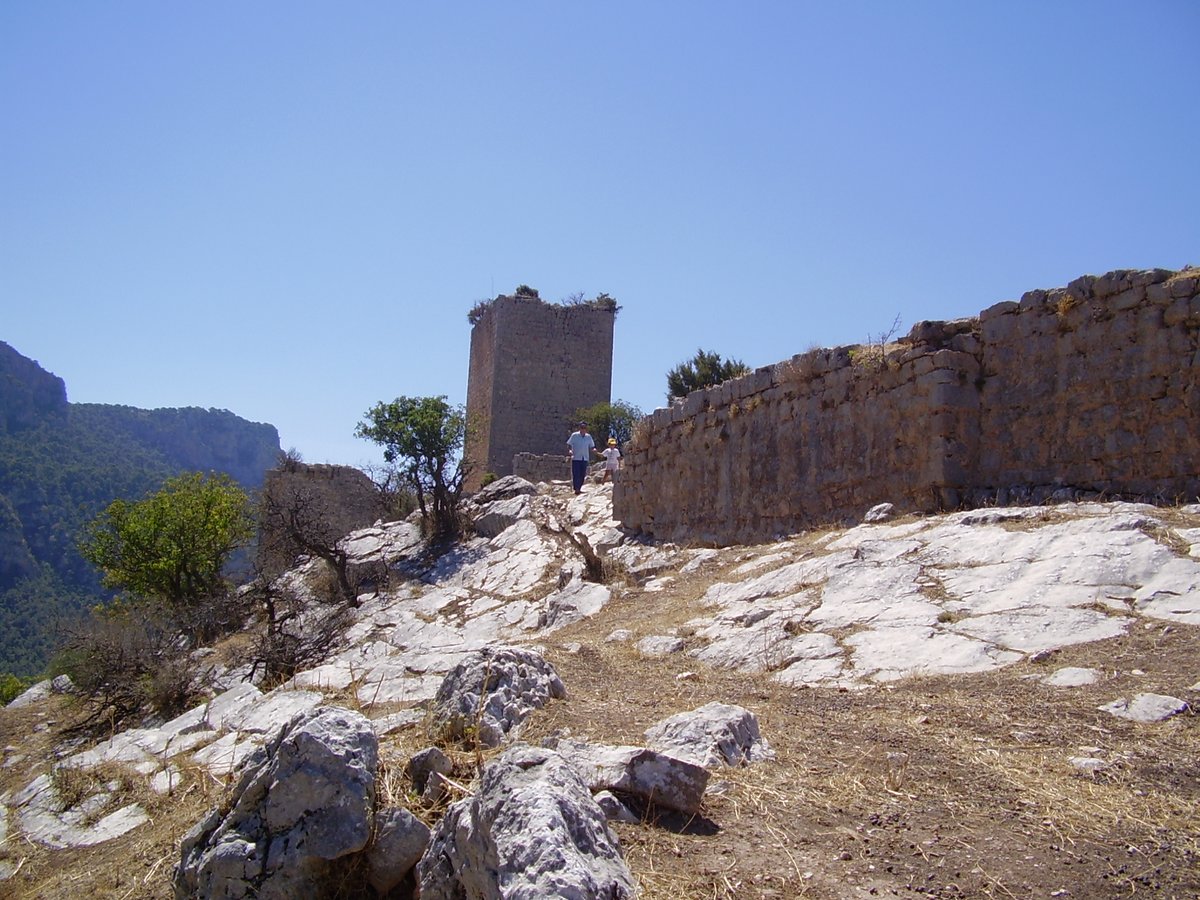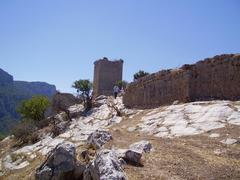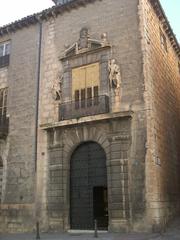
Comprehensive Guide to Visiting Castillo de Otíñar, Jaén, Spain
Date: 01/08/2024
Introduction
The Castillo de Otíñar, nestled in the municipality of Jaén, Spain, is a medieval fortress teeming with historical significance. This article uncovers the castle’s rich history, architectural evolution, and provides practical information for visitors. Whether you’re a history buff or a casual traveler, the Castillo de Otíñar offers a fascinating glimpse into Jaén’s past (castillosyfortalezasdejaen.com). The structure’s origins date back to the 13th century, built upon earlier Andalusian defenses. Over the centuries, the castle witnessed significant events, from the Reconquista to the eventual decline and abandonment of the surrounding village. Today, the Castillo de Otíñar stands as a testament to the region’s medieval history and strategic importance during the Reconquista (lugaresmiticosdejaen.com).
Table of Contents
- [Historical Background](#historical-backgroundhistorical-background)
- [Origins and Early History](#origins-and-early-historyorigins-and-early-history)
- [The Reconquista and Christian Conquest](#the-reconquista-and-christian-conquestthe-reconquista-and-christian-conquest)
- [Architectural Evolution](#architectural-evolutionarchitectural-evolution)
- [Role in Regional Defense](#role-in-regional-defenserole-in-regional-defense)
- [Decline and Abandonment](#decline-and-abandonmentdecline-and-abandonment)
- [Preservation and Cultural Significance](#preservation-and-cultural-significancepreservation-and-cultural-significance)
- [Visiting Information](#visiting-informationvisiting-information)
- [Castillo de Otíñar Visiting Hours](#castillo-de-otíñar-visiting-hourscastillo-de-otíñar-visiting-hours)
- [Castillo de Otíñar Tickets](#castillo-de-otíñar-ticketscastillo-de-otíñar-tickets)
- [How to Get There](#how-to-get-therehow-to-get-there)
- [Special Events and Guided Tours](#special-events-and-guided-toursspecial-events-and-guided-tours)
- [Travel Tips and Nearby Attractions](#travel-tips-and-nearby-attractionstravel-tips-and-nearby-attractions)
- [Travel Tips](#travel-tipstravel-tips)
- [Nearby Attractions](#nearby-attractionsnearby-attractions)
- [FAQ](#faqfaq)
- [Is there an admission fee for Castillo de Otíñar?](#is-there-an-admission-fee-for-castillo-de-otíñaris-there-an-admission-fee-for-castillo-de-otíñar)
- [What are the visiting hours for Castillo de Otíñar?](#what-are-the-visiting-hours-for-castillo-de-otíñarwhat-are-the-visiting-hours-for-castillo-de-otíñar)
- [How do I get to Castillo de Otíñar?](#how-do-i-get-to-castillo-de-otíñarhow-do-i-get-to-castillo-de-otíñar)
- [Are there guided tours available?](#are-there-guided-tours-availableare-there-guided-tours-available)
- [Conclusion](#conclusionconclusion)
Historical Background
Origins and Early History
The Castillo de Otíñar’s origins can be traced back to the second half of the 13th century, likely built upon pre-existing Andalusian structures. These earlier structures may have included a slope crowned by a dry stone palisade supported by a wooden framework (castillosyfortalezasdejaen.com). During the Muslim domination of the region, a rural settlement known as the town of Otíñar emerged near the current castle site, primarily agricultural with rudimentary defenses made of earth and wood. Traces of these early defenses can still be found along the escarpment of the hill.
The Reconquista and Christian Conquest
In 1228, King Fernando III of Castile reached a location referred to as ‘Atorimar,’ believed to be Otíñar. According to historical documents, King Fernando III and his troops devastated the area before continuing their advance (castillosyfortalezasdejaen.com). Following the Pacto de Jaén of 1246, Otíñar’s proximity to the new border made it a strategic point for monitoring the road to Granada. This period saw the construction of the Castillo de Otíñar, which played a crucial role in the defensive system of Jaén, allowing for visual communication with other watchtowers, such as Torrebermeja, which connected with the imposing Castillo de Jaén.
Architectural Evolution
The Castillo de Otíñar underwent significant architectural changes over the centuries. Initially, it may have consisted of a simple slope with a dry stone palisade. However, in the 15th century, the defensive capabilities of the castle were enhanced with the construction of an alcazarejo, a small fortress within the larger structure (castillosyfortalezasdejaen.com). The castle features an elongated layout with a masonry enclosure that takes advantage of the natural defenses on its eastern side. The remaining walls are more substantial, including a small bastion on the western side. Within the enclosure, there are remnants of residential buildings and a cistern (es.wikipedia.org).
Role in Regional Defense
The Castillo de Otíñar was an integral part of the defensive network protecting the city of Jaén. Its strategic location allowed for visual communication with other fortifications, creating a vital network for regional security, particularly against incursions from the Nasrid Kingdom of Granada (castillosyfortalezasdejaen.com). In the 14th century, a population center developed around the castle, also named Otíñar. This settlement was designated as an alcaldía (mayoralty) and had its own church. The 1464 Ordinances indicate that the mayor received an annual salary of 8,000 maravedís and was responsible for maintaining three men for the castle’s guard and defense.
Decline and Abandonment
Despite its strategic importance, the Castillo de Otíñar eventually fell into disuse. The surrounding village of Otíñar was inhabited until 1970, but the castle itself was abandoned much earlier. Today, the castle stands as a testament to the region’s medieval history and the strategic significance of Jaén during the Reconquista (lugaresmiticosdejaen.com).
Preservation and Cultural Significance
The Castillo de Otíñar is considered a Bien de Interés Cultural (Asset of Cultural Interest), highlighting its historical and cultural significance. Efforts to preserve and study the castle continue, ensuring that this important piece of Jaén’s heritage remains accessible to future generations (es.wikipedia.org). The castle’s architecture and location in the Andalusian landscape make it a site of great historical and patrimonial interest. Visitors to the Castillo de Otíñar can explore the remnants of its defensive structures, residential buildings, and cistern, gaining insight into the medieval history of Jaén and the broader region (castillosyfortalezasdejaen.com).
Visiting Information
Castillo de Otíñar Visiting Hours
The Castillo de Otíñar is open to visitors year-round, but it’s best to check local resources or the official Jaén tourism website for the most up-to-date visiting hours. Generally, the site is accessible during daylight hours.
Castillo de Otíñar Tickets
There is no admission fee to visit the Castillo de Otíñar. However, donations are appreciated to support ongoing preservation efforts.
How to Get There
The castle is located in the municipality of Jaén. Visitors can drive to the site, with parking available nearby. Public transportation options may be limited, so it is advisable to rent a car or join a guided tour.
Special Events and Guided Tours
Occasionally, special events and guided tours are organized at the Castillo de Otíñar. These provide a deeper insight into the site’s history and significance. Check the official tourism websites for more information.
Travel Tips and Nearby Attractions
Travel Tips
- Wear comfortable shoes suitable for walking on uneven terrain.
- Bring water, especially during the hot summer months.
- A hat and sunscreen are also recommended.
Nearby Attractions
While in Jaén, consider visiting other historical sites such as the Castillo de Jaén, Torrebermeja, and the Jaén Cathedral. Each of these sites offers unique insights into the region’s rich history.
FAQ
Is there an admission fee for Castillo de Otíñar?
No, there is no admission fee to visit the Castillo de Otíñar. Donations are appreciated to support preservation efforts.
What are the visiting hours for Castillo de Otíñar?
The castle is generally accessible during daylight hours. Check local resources or the official Jaén tourism website for the most up-to-date information.
How do I get to Castillo de Otíñar?
The castle is located in the municipality of Jaén. Driving is recommended, with parking available nearby. Public transportation options may be limited.
Are there guided tours available?
Yes, occasionally special events and guided tours are organized. Check the official tourism websites for more information.
Conclusion
The history of the Castillo de Otíñar provides a fascinating glimpse into the medieval history of Jaén and its strategic importance during the Reconquista. From its origins as a simple defensive structure to its role in a complex network of fortifications, the castle stands as a testament to the region’s rich and turbulent past. The site’s architectural evolution, from its initial construction to the enhancements in the 15th century, reflects the changing needs and technologies of its time. Despite its abandonment, Castillo de Otíñar remains a significant cultural landmark, designated as a Bien de Interés Cultural (es.wikipedia.org). Visitors can explore the remnants of its defensive structures, residential buildings, and cistern, gaining insight into the medieval history of Jaén and the broader region. Plan your visit today and immerse yourself in the captivating history of Jaén (castillosyfortalezasdejaen.com).
References
- Castillos y Fortalezas de Jaén. (n.d.). Castillo de Otíñar. Retrieved from https://castillosyfortalezasdejaen.com/castillos/castillo-de-otinar.html
- Wikipedia contributors. (n.d.). Castillo de Otíñar. In Wikipedia, The Free Encyclopedia. Retrieved from https://es.wikipedia.org/wiki/Castillo_de_Otíñar
- Lugares Míticos de Jaén. (n.d.). Otíñar. Retrieved from https://lugaresmiticosdejaen.com/es/articulos/lugares/otinar




